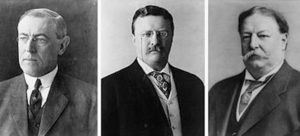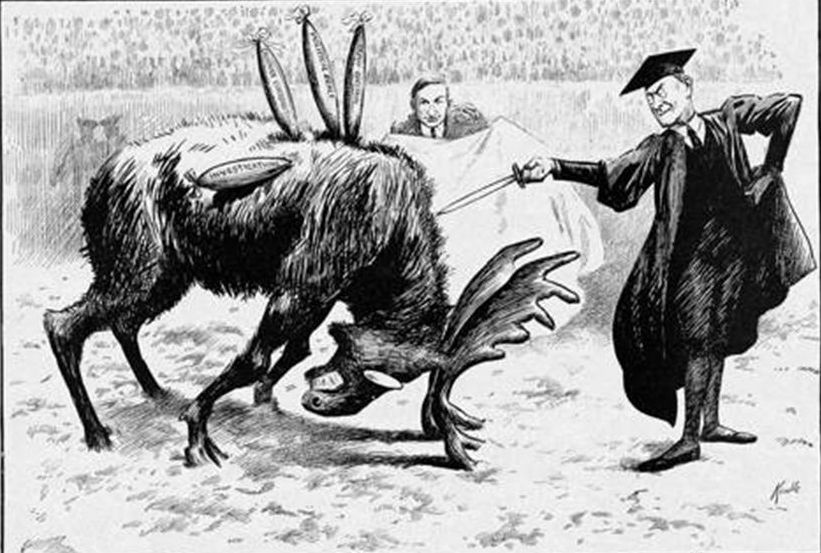The one word consistently used to describe the 2016 Presidential Election Cycle is “unprecedented.” It is unprecedented that a figure like Trump swooped in to take over a major political party; it is unprecedented that the Democrats nominated a figure with unfavorables as high as Hillary Clinton; it is unprecedented that Americans are so displeased with both major party nominees that many are considering voting for a third party.
While some claims about the bizarre nature of this cycle certainly have merit, to state that the choices presented to the American people this year are uniquely terrible is to stand athwart electoral history. Each election is inherently different — and the antics of 2016 validate that — but when the choices are boiled down to their core ideological elements, it becomes increasingly clear that this cycle’s analogue is 1912.
The first similarity is cosmetic: both years had three major candidates competing for the nation’s highest office. Currently, Republican Donald Trump, Democrat Hillary Clinton, and Libertarian Gary Johnson will be on the ballot in all 50 states. In 1912, the top contenders were incumbent Republican President William H. Taft, Democratic challenger Woodrow Wilson, and Progressive (or Bull Moose) Party standard-bearer Theodore Roosevelt.
Each of the aforementioned candidates has a parallel partner across time; not so much in style, but in policy. The following comparisons flesh out a handful of the unnerving similarities between this cross-sectional group.

The Progressive Nationalists: Donald Trump and Teddy Roosevelt
Donald Trump succeeded with the older voters in the GOP electorate by appealing to their populist and frankly nationalistic tendencies. The two issues that have been at the center of his campaign platform which he is certain will “Make America Great Again” are the inherently nativist policies on trade and immigration.
On trade, Mr. Trump is unabashedly pro-tariff and pro-protectionism. He consistently cites “being ripped off” by other countries in his stump speeches as justification for free trade restrictions with a consistent track record of failure. On immigration, his nationalistic language goes beyond just wanting to build a wall. His campaign oozes of the yearning to return America to something greater, which really means a return to state-sponsored discrimination.
Like the Donald, Roosevelt also supported protective tariffs. But given the fact that he held the office, Roosevelt went much farther. He used the power of the presidency to become a “trust-buster” of magnanimous proportions. During his administration, the U.S. government brought 40 antitrust suits, and broke up major companies, such as the largest railroad and Standard Oil, the largest oil company.
Furthermore, Roosevelt’s corollary to the Monroe Doctrine and his exploitation of the geographic resources of Panama are remarkably like Trump’s “take the oil” stance towards current day foreign policy quandary: the Middle East.
Both men viewed themselves as agents of a common white man’s government that could use its power to restore national greatness. But like Roosevelt, a Trump presidency would do nothing but extend the powers of the executive and disregard essential constitutional safeguards for minority rights.
The Imperial Democrats: Hillary Clinton and Woodrow Wilson
Hillary Clinton is unique among Democrats to get the presidential nomination post 1972 because she is unabashedly pro-intervention. With previous nominees Barack Obama and John Kerry making opposition to Middle Eastern wars a centerpiece of their campaigns, Hillary must own her vote in favor of military action in Iraq.
As Secretary of State, she promoted U.S. intervention in both Libya and Syria; situations which are now almost universally considered to be disasters. The liberal website The Huffington Post even ran an editorial called “Hillary Is the Candidate of the War Machine” that attacked her record as a senator and a diplomat. In that article, author Jeffrey Sachs harshly stated, “perhaps more than any other person, Hillary can lay claim to having stoked the violence that stretches from West Africa to Central Asia and that threatens US security.”
All of Clinton’s moves on the foreign policy front are straight out of the Woodrow Wilson textbook. The man obsessed with “making the world safe for democracy” made a career out of botched coalition building and involving the U.S. in wars in which in had no rightful business being in. But while foreign policy is the greatest similarity between these two figures, it is not the only one.
Both politicians have a strong affinity for the income tax: Hillary proposes increasing taxes on high earners and Wilson reintroduced the income tax after the passage of the 16th Amendment. Interestingly enough, both also have controversial connections to the banking industry that drew attacks from their political left. Hillary has a well documented cozy relationship with big Wall Street banks, many of whom she voted to bailout in 2008. Woodrow Wilson worked to pass the Federal Reserve Act of 1913 that forever created a tangled web of cronyism in the American banking system.
The “Moderates”: Gary Johnson and William Taft
Similarly to 1912, many small-government conservatives and libertarians (then a part of the “Old Right” coalition) are without an enthusiastic third option. Incumbent William Howard Taft, like former New Mexico Governor Gary Johnson, was seen as the least bad choice in a rotten batch.
Johnson won the Libertarian Party nomination by riding his successful record as a libertarian-ish Republican governor. He checks off many of the boxes: he favors lower taxes, wants fewer military interventions, favors personal choice on sexual and drug related issues, and generally supports decreased regulation. These stances alone allow Johnson to stand head and shoulders above the other candidates on matters of policy, especially in 2016.
But these stances alone do not a bona fide libertarian make. Johnson has consistently shown a lack of understanding of essential ideological doctrine, and his “bake me a cake” iteration of libertarianism — as Tom Woods so brilliantly pointed out — eschews the sacrosanct nonaggression principle. Because of his media branding as “fiscally conservative, socially liberal” and selection of non-libertarian Bill Weld as his running mate, Johnson is best viewed as the palatable moderate.
Taft was even less of a libertarian than Johnson is; in fact, he was not one at all. But his more moderate approach towards trust busting and foreign interventionism made him a “better” candidate than the extreme progressives to his left and right. Taft’s more conservative approach, and respect for the separation of powers thought by his rivals to be archaic, earned him the moniker of the “correct” vote according to #NeverTrump columnist George Will.
Taft finished third, as Johnson likely will, but was the only voice in the room asking for government to slow down. An imperfect solution, but one different from Johnson’s only in degree rather than type.




2 comments
… [Trackback]
[…] Information on that Topic: thelibertarianrepublic.com/familiar-choices-why-2016-is-eerily-similar-to-1912/ […]
… [Trackback]
[…] Read More Information here on that Topic: thelibertarianrepublic.com/familiar-choices-why-2016-is-eerily-similar-to-1912/ […]